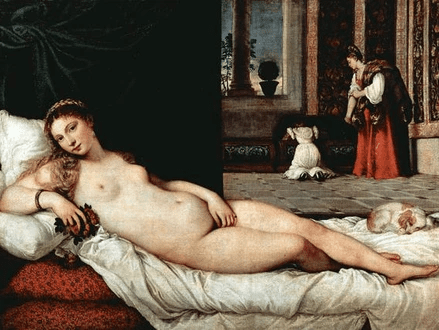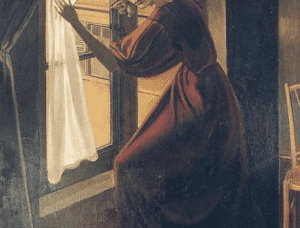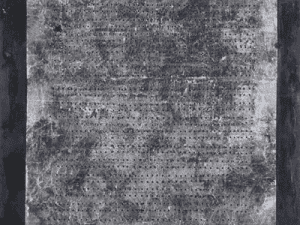Title of Artwork: “Venus of Urbino”

Artwork by Titian
Year Created 1534
Summary of Venus of Urbino
This is one of the most recognisable and influential nudes of all time. It depicts a lady as she reclines on a crimson couch covered in white blankets and stares at the spectator. It’s all gold and jewels on her right arm; she holds a flower with one red petal falling off, and her left hand is resting on her genitals in the famous pudenda posture. She’s wearing nothing else. A tiny dog snoozes above her feet, while an elderly lady in a robe observes a younger woman kneeling before an open cassone, or chest, typically used for wedding clothing in the top right background. An expansive green landscape can be seen to the left of the two.
All About Venus of Urbino
With the top half of the composition vertically split by a black backdrop and a scene of two ladies in a tiled room behind the nude, her reclining body dominates the bottom horizontal plane, further accentuating her languorous shape. As a consequence, the painting creates a sense of an intimate contact with the nude, the implied masculine gaze of the customer viewing her as though “for his eye’s only.” by separating public and private space.
Various interpretations have been made of the work’s components, including the cassoni and the traditional emblem of faithfulness, the dog. Cardinal Ippolito de’ Medici and his lover or courtesan are both said to have ordered the painting. The Duke of Camerino is supposed to have ordered it for his wedding. Jonathan Jones, an art critic, wrote: “By blurring generic boundaries, the piece feeds the uncertainty surrounding the protagonist’s socioeconomic class in order to make it more difficult for viewers to identify him or her. Pagan symbolism and a private vision that celebrates marriage are both present in this painting.”
Also reminiscent to Giorgione’s Sleeping Venus (c. 1510-1511), some academics claim that both portray the same figure exhibited on the same bed drapes.’ Titian, on the other hand, has used a modern interior environment to showcase the naked body’s undeniable sexiness. It is yet to be shown that the most renowned example of this type, Titian’s Venus of Urbino, is anything except a picture of a lovely nude lady on a bed, devoid of classical or even allegorical significance,” art historian Charles Hope stated.
Everything About Venus of Urbino
Legendary Renaissance artwork, this Venus of Urbino depicts a reclining female nude in a life-size form and is considered one of Venice’s finest masterpieces. Giorgione, a close friend of the artist, had already painted The Sleeping Venus (1510), but Titian’s depiction of the goddess is far more sensual. To enhance this sensuality, she is shown in a sumptuous home setting without any allegorical or mythical motifs connected with Venus, and the nude’s direct stare, her subtle grin, and her awareness of the observer all contribute. The nakedness in Giorgione’s work is idealised and modest, but in Titian’s work it is shown as genuine and seductive. She stands out from the darker, more opulent backdrop because of the contrast between her skin’s warm, bright tones and the chiaroscuro used to create a sculptural nude. Architectural features such as the tiled floor, a classical column and a green hanging that bisects the picture also contrast with her curvy shape and emphasise her fertility.
Among the most controversial images in Western art, including The Nude Maja by Goya and Olympia by Edouard Manét, is Titian’s depiction of female sensuality in this painting, which is often cited as the source of many of these images. It is also considered to be the original precursor to the pin-up.
Possibly to commemorate his marriage to Giuliana Varano, Guidobaldo della Rovere (after the Duke of Urbino) had Titian create this portrait for him. After all, Venus is no courtesan and the picture doesn’t subtly encourage casual adultery. As a result of this, considering that it was painted to honour Guidobaldo’s marriage, it is likely definitely a celebration of marital love and the physical closeness between husband and wife. Her right hand is holding a posy of flowers, which normally symbolises love; the sleeping dog is also a classic sign of faithfulness; and the maids are seen digging about in a traditional cassone, where ladies often kept their wedding gowns in the background. The Duke’s young wife, Giuliana, may have been the inspiration for the painting. When it came to wedding photography, graphic sensual images were not out of the question, even if just for private viewing.
Among the Venus of Urbino’s many stylistic flourishes is this: Starting with the sensuous shapes of the girl’s figure, Titian creates a striking visual contrast with the straight lines of the separating screen as well as the floor tiles and other architectural components in the room. Titian’s subtle chiaroscuro and the movement of light on the girl’s torso give her a sculptural appearance while also emphasising the silky drapery of the bedsheets. Floral patterns on the sofa, cassoni, and backdrop tapestry, as well as the rich colour pigments of the screen and the maid’s attire, combine to unite and excite the composition, while the floor tiles give an additional linear viewpoint.
Titian had already established himself as Venice’s foremost Renaissance artist by the time he created this painting. Furthermore, his works were sought after by members of the Italian Royal Houses because of his extraordinary use of colour, which included church altarpieces, mythological paintings, portraits, and landscapes. Throughout the ages, Van Dyck, Poussin, Rubens, and Velazquez have regarded him as one of the greatest painters of all time. When it comes to portraiture, he paved the way for generations of artists to follow in his footsteps. Although he was a talented artist, his generosity of spirit was lacking, and he became known as a greedy and miserly person.
An oil painting by Titian known as the Venus of Urbino (also known as the Reclining Venus) is said to have been finished in 1534 but not sold until 1538. Traditionally, the goddess Venus is shown as a naked young lady lying on a sofa or bed in a lavish Renaissance castle. This piece is now on display at Florence’s Galleria degli Uffizi.
Based on the Dresden Venus, generally assigned to Giorgione but at least finished by Titian. Titian has domesticated Venus in this painting by bringing her inside, creating eye contact with the spectator, and emphasising her sexuality. With no classical or allegorical trappings, the image is sensuous and unashamedly carnal – Venus exhibits none of the characteristics she is intended to embody.
There are two distinct schools of thought when it comes to how to interpret this work of art. While the painting’s erotic charge is agreed upon, it is also interpreted as a portrait of Zaffetta, maybe, or as a piece of art commemorating the marriage of its original owner (who according to some may not have commissioned it). Titian’s Dresden Venus of circa 1510-11, which sparked a 25-year controversy about the meaning of the reclining female nude, lies at the heart of this argument.. There is no evidence that Titian’s Venus of Urbino is anything more than a lovely naked lady on a bed, devoid of classical or even allegorical substance, according to Charles Hope. Allegory-finder Edgar Wind was forced to concede that “an undisguised hedonism had at last dispelled the Platonic metaphors” in this instance.
The naked Venus looks directly at the observer, unfazed by the fact that she is being seen. She has a posy of flowers in her right hand, while her other hand is placed over her genitals. A dog, a common symbol of loyalty, may be seen lurking in the foreground. Background images depict two maids searching through an old cassone chest, which held clothing.
It’s uncommon, if not unprecedented, for Titian to show the inside in such fine detail. Ippolito de’ Medici, the nephew of Pope Clement VII, was named a cardinal (albeit not a priest) by his uncle, Titian, when he was only 21 years old. He was a papal ambassador and was pursuing a military career. Angela del Moro, or Angela Zaffetta, was a renowned prostitute in Venice and a frequent partner of Titian and Aretino, the latter of whom was a friend of the cardinal. He spent the night with her on October 20, 1532. A nude portrait of Angela Zaffetta may have been requested by Ippolito, or it may have been created by Titian in the hope that he would enjoy it.
Ippolito’s chamberlain received a letter from Titian on December 20, 1534, in which the artist said that he had been working on a painting for the cardinal. When Guidobaldo II della Rovere, the 24-year-old son of the Duke of Urbino, arrived at Titian’s workshop in January 1538, he was greeted by Ippolito, who had died in August 1535 and had never seen the painting. When he and his mother wrote to each other about the painting, he referred to it simply as “the nude woman” and feared that Titian would sell it to someone else. He purchased it some months later. That year he became Duke of Urbino after his father’s death, and thus the picture was renamed after him, although it seems to have been preserved at Pesaro from the beginning.
Information Citations
En.wikipedia.org, https://en.wikipedia.org/.
Recommend0 recommendationsPublished in Artworks






Responses